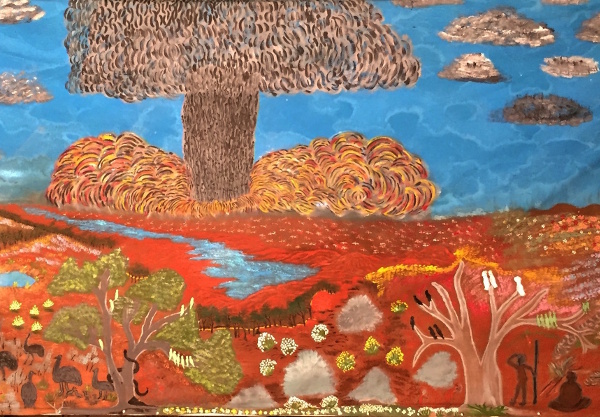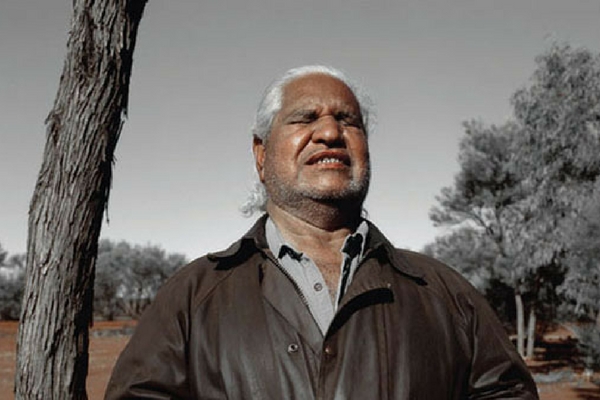70 Years on: The Art of UK Nuclear Testing


‘Maralinga’ banner detail: 2016, acrylic on canvas, full size 1.5m by 3m. Artists: Mima Smart and Rita Bryant. First exhibited at Tandanya National Aboriginal Cultural Institute in 2016. Photograph by Paul Brown.
On October 3rd 1952, the UK conducted its first nuclear tests in Australia. Seventy years on, Scottish CND is commemorating with indigenous artists and activists to explore what that has meant for them, along with some of the veterans who have also been affected. They are hosting a webinar, to provide information on the consequences of UK nuclear testing in Australia.Register here.
Seventy years ago the United Kingdom conducts its first nuclear test at Montebello Islands off the coast of Western Australia. It later conducts a series of tests at Maralinga and Emu Fields in South Australia. These are rural areas that the UK government of the 1950s regarded as unpopulated, despite the presence of aboriginal people.
Aboriginal people have written, spoken and made art as a means of communicating the terrible harm that they have experienced from the tests. JD Mittmann (Curator for the Black Mist Burnt Country exhibition) explains:
“Maralinga Tjukurpa is the title of the large painting produced by Yalata women for the Black Mist Burnt Country exhibition. The collection Life Lifted into the Sky was created alongside this larger painting. In Maralinga Tjukurpa, a greyish-blue cloud rises geyser-like into a dark sky above an unfamiliar landscape. The red dunes of the distant Great Victoria Desert shimmer blue like a volatile sea. In the foreground of the painting, clearly separated, bright colours indicate better, happier times. Flowers are blossoming. Individuals carrying piti (dishes) and sitting around camp fires live a peaceful existence.
Yet, on display is a sad and sinister story; and one that many Australians don’t know much about. The canvas is partly covered in dots of acrylic paint, a style that is typical for the central and western desert painting movements. It tells the story of the Pitjantjatjara Anangu people of South Australia, their dislocation from traditional lands, the exposure to atomic testing and the subsequent contamination of their country.
A total of seven atomic devices were tested by the British (with Australian Government approval and logistical support) from 1956-57 at Maralinga, accompanied by over 500 so-called ‘minor tests’. Ironically, those later trials produced much of the most devastating and long-lasting contamination of Anangu country. Despite several clean-up efforts sections of the land will remain inhabitable for generations to come.”
No Reward
The colonial nature of the relationship between the UK and Australia meant that the Australian prime minister Robert Menzies accepted the opportunity to host the atomic tests with hapless ardour and relinquished any control over how and when they were to be conducted. The Australian public was given no information about the tests which offered no benefit or reward to Australia
The explosions not only caused immediate destruction but the radioactive fallout and toxic pollution caused longer-term harms which, for some families, continue down through generations.
These tests were not only devastating for the lives, culture and health of the Indigenous communities, but they also resulted in permanent radioactive contamination of the land itself. The traditions of living from the land and in the open put indigenous people at even greater risk than would have been the case, a risk of harm from radioactive particles that lasts beyond the lifetimes of those present at the tests, Minimal efforts were made to warn aboriginal people. Where warning was given, there was no protection offered, it only meant that Aboriginal people were denied access to their traditional lands.
After the death of her unborn daughter, a second-generation survivor of the Maralinga test said “I wonder, if my sisters or my sons have children, are there going to be more of our babies that are born with tumours and are they going to have to suffer the grief that I carry?”
Yami Lester – Yankunytjatjara Elder, atomic test survivor, Aboriginal rights activist, father, grandfather and great-grandfather, spoke of the experience.
Yami lost his sight as a result of one of the British atomic bomb tests in SA in 1953. Speaking on ABC radio in 2011, he said: “I was a kid. I got up early in the morning, about 7:00am, playing with a homemade toy. We heard the big bomb went off that morning, a loud noise and the ground shook. I don’t know how long after we seen this quiet black smoke ‒ oily and shiny ‒ coming across from the south. Next time we had sore eyes, skin rash, diarrhea and vomiting everybody, old people too.”


Along with Maralinga veteran Avon Hudson, Yami was responsible for the formation of a Royal Commission in the 1980s that shone a light on the atomic crimes of the British government, the spinelessness and culpability of state and federal governments, and the ugly racism that pervaded everything to do with the atomic bomb tests.
The tests in Australia shine a light on the facade of colonial rule much-celebrated and distorted in recent weeks. But nuclear testing happened across the world affecting indigenous and powerless people, as ICAN Storytelling explains here: “The last nuclear weapons test above ground took place in 1980 and the last underground explosion in 2017. But those impacted by these tests remember those explosions and their lasting repercussions. And as they remember, they fight for justice for their own communities and other survivors of nuclear testing around the world.”
Read more about their stories here ‘Surviving Nuclear Testing’.

British B******s. We in Scotland are next for testing out the real thing.
I watched a documentary on the Maralinga nuclear testing recently (I think it was called Maralinga Tjarutja). The British government took the opportunity of the 70th anniversary today to honour and fund its own nuclear test veterans (the perpetrators, albeit under military orders) but I cannot see anything for the other victims.
https://www.gov.uk/government/news/government-pays-tribute-to-nuclear-test-veterans-as-uk-marks-70th-anniversary-of-first-weapons-test
Calling it a nuclear ‘deterrent’ is inaccurate, since the British and NATO have always had nuclear first strike policies, and the British even envisaged using them in colonial wars against independence movements.
The political repercussions echo on today. The British authorities will be wary of criticising China’s nuclear testing programme in the Uygur autonomous region because it did the same or worse itself.
The person who bears ultimate responsibility for these crimes is the Queen. It is a pity she was never held to account.